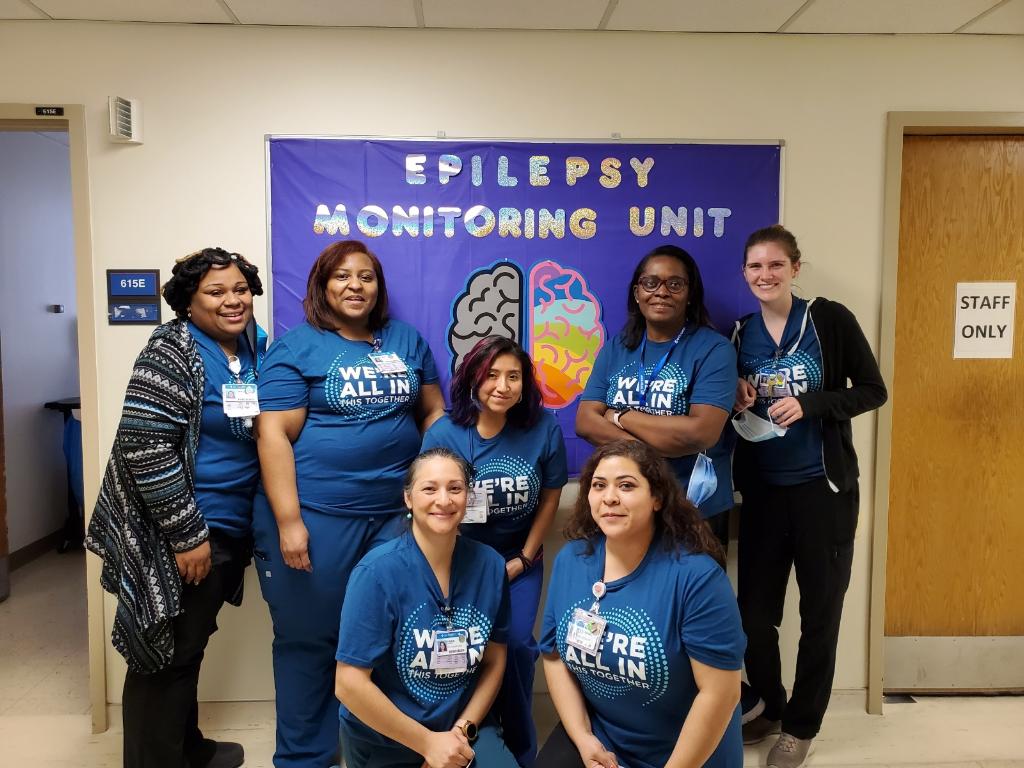UI Health Epilepsy Program: PAUSE and the EMU
UI Health Epilepsy Program: PAUSE and the EMU Heading link

Epilepsy is the fourth most common neurological disease. It affects as many as one in 26 people in their lifetime and 50 million people worldwide. The hallmark of this chronic disorder is recurrent, unprovoked seizures that may involve part (partial) or the entire body (generalized) and are sometimes accompanied by loss of consciousness and loss of bowel or bladder function. The diagnosis of epilepsy type depends on the type of seizure experienced, age of seizure onset, genetic history, and any presence of brain lesions.
The Epilepsy Program at UI Health is a team of epileptologists, neurosurgeons, neuropsychologists, and nurses highly specialized in epilepsy management. The Epilepsy Team works together to provide individualized treatment and management plans for every patient. The epilepsy group is also involved in many research projects, both basic science and clinical. UI Health is accredited as a Level 3 Epilepsy Center by the National Association of Epilepsy Centers for expertise in evaluating, monitoring, and treating patients with complex epilepsy.
The Epilepsy Monitoring Unit (EMU) at UI Health uses the latest technology to diagnose, monitor, and treat epilepsy. Patients in the EMU are evaluated using continuous video electroencephalography (EEG) which measures the electrical activity in the brain over the video to record body movements during seizures and to better understand seizures and seizure onset. Patients are monitored continuously to keep patients safe and to gather all necessary information. While epilepsy can often be managed with medication, 30% of patients do not respond to their medications and continue to have seizures. In this case, individuals with epilepsy may also be admitted to the EMU for presurgical evaluation as surgery is the next step for treatment. Part of the presurgical evaluation is intracranial EEG monitoring which, using an innovative cranial robotic guidance program and robot-assisted electrode positioning, can provide more precise localization of seizures within the brain. This helps with surgery that involves the removal of a small portion of the brain—resective surgery.
In the outpatient setting, The Epilepsy Program offers specialty epilepsy clinics dedicated to refractory epilepsy, complex epilepsy, and women with epilepsy. The dedicated clinic for women with epilepsy, led by Dr. Anna Serafini, works to address and discuss how epilepsy drugs may affect birth control, hormone levels, pregnancy, and the female reproductive cycle. Dr. Serafini works closely with patients’ primary care physicians and OB/GYNs to provide comprehensive care for all women with epilepsy. An additional specialty clinic led by Dr. Jeffery Loeb is dedicated to patients affected by Sturge Weber Syndrome which is a rare vascular disorder characterized by a large facial birthmark (a port-wine stain) as well as neurological abnormalities and glaucoma. The Sturge-Weber Foundation has designated the University of Illinois Hospital & Health Sciences System a Center of Excellence for providing exceptional care to patients living with Sturge-Weber Syndrome.
From a research perspective, one of the epilepsy group’s goals was to understand the epidemiology of patients that have trouble controlling seizures even with medication and what would help this underserved patient population improve epilepsy management. For many of these patients, frequent and severe seizures can severely undermine their ability to work, sustain relationships, live independently, and think clearly, and these patients may encounter stigma or experience depression. Deeply challenged patients have trouble learning epilepsy self-management skills to help control their epilepsy. Together with the Epilepsy Foundation, The Epilepsy Program found a way for this patient population to improve self-management by combining the resources of “epilepsy.com” with a wireless electronic device that allows real-time web conferencing and personalized education programming for patients and their families. The patient uses the device at home for 10-12 weeks and the patient, physician, family, and nurse collaborate in tailoring the program pace and components for the patient’s needs. This project is called “Personalized Internet-Assisted Underserved Self-Management of Epilepsy (PAUSE) to Learn About Your Epilepsy.”
Additionally, the epilepsy center is part of a multi-center, multi-investigator research team funded by CURE grant focused on improving ways to study post-traumatic epilepsy in a laboratory setting, develop biomarkers, and understand risk factors to help us predict who will develop post-traumatic epilepsy following traumatic brain injury. In particular, the epilepsy team focuses on subarachnoid hemorrhage (SAH) and development of epilepsy with aims concentrating on identification of early imaging, laboratory and clinical findings to predict the development of epilepsy following SAH, creation of an animal model of SAH and epileptogenesis, and finding common EEG biomarkers in humans and animal models.
Dr. Loeb and a team of physicians, scientists, and engineers have completed the construction of the University of Illinois NeuroRepository (UINR). The UINR is a one-of-a-kind human tissue and data repository focused on turning extremely large datasets including thousands of genes, proteins, and molecules generated from clinical, radiological, electrical, and histological data into cures. The UINR is the first to dramatically enhance the utility of these datasets and, for epilepsy patients, the UINR’s goal is to collect information regarding the brain tissue obtained from epilepsy surgery. By co-registering each piece of tissue removed with the electrical activity recorded from that tissue prior to removal, the UINR team can begin to understand what makes these abnormal brain regions epileptic. The group has discovered highly consistent patterns of genes liked to specific epileptic activities, localized these genes to specific layers of neurons in the brain, and identified a drug that can prevent these genes from causing epilepsy in animal models; the UINR’s research is leading to important clues for a cure.